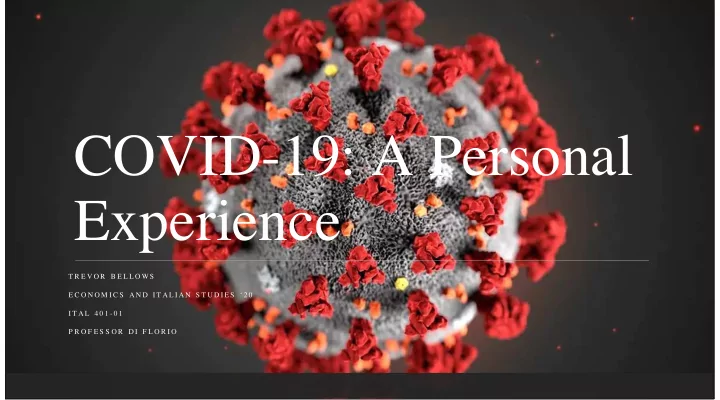

COVID-19: A Personal Experience T R E V O R B E L L O W S E C O N O M I C S A N D I T A L I A N S T U D I E S ‘ 2 0 I T A L 4 0 1 - 0 1 P R O F E S S O R D I F L O R I O
COVID-19 COVID-19 stands for “Coronavirus Disease 2019.” This disease was first identified in December of 2019 in Wuhan, China. The virus rapidly spreads from close contact. Since then, the number of cases has dramatically increased, and the virus is categorized by the WHO as a “pandemic.” Large-scale efforts are being made to limit human-to-human contact in order to slow the spread of the virus.
My Experience I work as an EMT for an ambulance service in Trumbull, CT (Fairfield County). Each week, I work between 40 and 60 hours on the ambulance. Fairfield County is the hardest hit location in CT at the moment. At present, upwards of +60% of emergency transports to the local hospital test positive for COVID. Personal Protective Equipment (PPE) is used to protect EMS personnel from the virus.
A Typical Shift 6:00AM: Arrive at the station and receive the truck assignment. 6:05AM:Begin checking equipment, place truck into service. 6:15AM:Account for all PPE in truck. Bring PPE into front cab for easy access. 6:30AM:Decontaminate truck fully. 9:00AM: Daily company meeting for changes in policies and procedures. 12:00PM:Lunch if there aren’t any calls. 6:00PM: Nighttime meeting. Take a late call and be held for up to 4 more hours. **911 calls happen at any time and all day long. Each call requires fully donning of PPE and complete decontamination of the trucks. After a COVID+ patient, the truck is decontaminated and put right back into service to pick up the next infected patient.
Personal Protective Equipment (PPE) With any suspected COVID Emergency, we enter wearing any of the following: • N95 Mask • Surgical Mask • Eye goggles or safety glasses • Face Shield • Isolation Gown • Tyvek Suit • Gloves • Booties • Hair Caps • Neck Hoods
Reflections To me, the pandemic is an eye-opening experience. Each day when I walk into work, I am saddened to be greeted by the death and trauma that comes from the virus. It is sad knowing that I could be potentially removing a patients from their house, knowing that it will be the last time they are ever in their home. I know that this virus will leave a lasting impact on me for many years to come. From this pandemic, we can learn how to better manage biological threats and reevaluate our healthcare system. It is hard to avoid the question; “Could I have done better?” But, I reassure myself that I give every emergency my best and don’t look back on the results as a reflection of my work.
Conclusion From this pandemic, we have seen many positive aspects. The community has come together in many different ways, even through maintaining social distancing. There is a renewed respect for doctors, nurses, and first responders. Many volunteers have come together to donate food, donate PPE, make masks, or volunteer to help with victims of the virus. Going forward, I will view the world as more fragile, always keeping in mind how fast it can change.
Recommend
More recommend